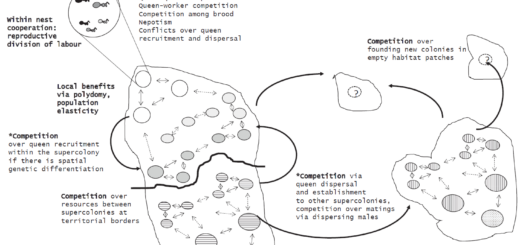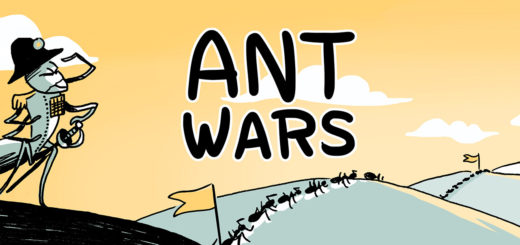Organization of the behavioral repertoire in the trap-jaw ant Odontomachus chelifer
In the recent paper “Worker-behavior and behavior-behavior interaction networks in the trap-jaw ant Odontomachus chelifer (LATREILLE, 1802) (Hymenoptera: Formicidae)” published in Myrmecological News, the authors Neves, F.M., Borges, M.E., and Pie, M.R. analyze the division of labor in the ant O. chelifer. They focus on how individuals and their different behaviors correspond to division of labor and analyzed individual-behavior and behavior-behavior interactions to detect complex behavioral patterns. Here, Sarah Bengston highlights their main points.
A Review by Sarah Bengston

Division of labor is perhaps one of the most defining characteristics of ant colonies. Even those who do not share our myrmecological love often have some basic understanding that different ants do different things, though precisely what these tasks are or who is doing what may be elusive. It’s perhaps surprising then, that despite this being such a universally observed, described, and studied phenomenon, in many ways we as researchers are left with the same unknowns.
Of course, there is no paucity of research investigating division of labor. There is an unresolved debate to what extent the organization of division of labor is determined by colony-level dynamics, such as size, an independent developmental process such as age polyethism or plastically in response to colony needs. Many theoretical and empirical studies exist on how division of labor could scale with colony size (Beshers and Fewell, 2001). For instance, Holbrook et al. (2011) directly tested if social scaling, or “group-size effects” influences division of labor in the harvester ant Pogonomyrmex californicus. In theory, small efficiency benefits provided by division of labor should scale with colony size, meaning larger colonies should benefit more from division of labor than small colonies. Holbrook et al. 2011 find support for this hypothesis: as colonies increase in size, there is an increase in division of labor. Additionally, this result is consistent with the observation that morphological specializations (e.g. discrete morphological castes such as soldiers, which boast specialized armor and weaponry), are primarily seen in species with large colony sizes (Anderson and McShea, 2001).
We also know that colony-level determinants are not the only influence on the task repertoire and specialization of individuals within the colony. For example, Seid and Traniello (2006) found that the task repertoire of Pheidole dentata workers expands with age; younger ants respond to fewer odorant cues than older workers. Division of labor does not always predict improved performance, either. Dornhaus (2008) found that individual workers of Temnothorax albipennis ants varied in their ability to perform tasks, but this variation was not a determinant of an individual’s likelihood to perform that task; meaning an individual was not necessarily specializing in the task they were best at. Further, some ants may be specialized at doing nothing at all, and appear to be the ‘lazy ants’ of a colony (Charbonneau and Dornhaus, 2015).
What becomes clear when assessing the body of work investigating division of labor in ants is that while there is a plethora of studies, division of labor is multi-faceted and the byproduct of complex internal and external factors. As a result, there is a need for studies that embrace this complexity and use new approaches that can reflect the interconnected factors at work. Some studies have begun this, such as Pasquaretta & Jeanson (2018), which use bipartite networks to look at different specialization nodes in a network. However, a recently published manuscript “Worker-behavior and behavior-behavior interaction networks in the trap-jaw ant Odontomachus chelifer (Latrille, 1802) (Hymenoptera: Formicidae)” by F.M Neves, M. E. Borges, and M. R. Pie, goes beyond this approach. The authors expand upon previous time budget approaches (where behaviors are categorized and the duration of time individuals spend doing said behaviors during their active period is recorded) by considering two distinct network types, namely worker-behavior and behavior-behavior interactions. Specifically, the authors observed Odontomachus chelifer ant colonies, and the activities of the ants were then separated into these two network types. This approach allows for complementary results, and allows us to see further into the dynamics revealing complex behavioral interactions, which pays off when we see the presented results. The authors demonstrate that not only is there variation in specialization between workers, but that some behaviors like self-grooming appear to have a disproportional impact on the structure of the behavioral network.

This study highlights the importance of continuing to develop rigorous approaches to measuring complex behaviors, or even more broadly, the complexity of life that exists. While more derivative approaches are perhaps frequently more practical (indeed, Neves and colleagues note that the manual observation and recording of behaviors would make this approach unfeasible for larger colonies or for over longer periods of time), it is at the expense of capturing important mechanisms. We should aim to further collaborative work with other fields (e.g. computer scientists working on automated tracking software, machine learning, and swarm robotics), which can help us bridge the gap between what is currently feasible and what information would give us a more holistic understanding of division of labor.
References
Anderson, C. &McShea, D.W. (2001): “Individual versus social complexity, with particular reference to ant colonies.” – Biol. Reviews 76: 211-237.
Beshers, S.N. &Fewell, H.H. (2001): “Models of division of labor in social insects.” – Annual rev. entomol. 46: 413-440
Charbonneau, D. & Dornhaus, A. (2015): Workers ‘specialized’ on inactivity: Behavioral consistency of inactive workers and their role in task allocation. – Behav. Ecol. Sociobiol. 69: 1459–1472. https://doi.org/10.1007/s00265-015-1958-1
Dornhaus, A. (2008): Specialization Does Not Predict Individual Efficiency in an Ant. – PLOS Biol. 6, e285. https://doi.org/10.1371/journal.pbio.0060285
Holbrook, C.T., Barden, P.M. & Fewell, J.H. (2011): Division of labor increases with colony size in the harvester ant Pogonomyrmex californicus. – Behav. Ecol. 22: 960–966. https://doi.org/10.1093/beheco/arr075
Pasquaretta, C. & Jeanson, R. (2018): Division of labor as a bipartite network. – Behav. Ecol. 29: 342–352. https://doi.org/10.1093/beheco/arx170
Seid, M.A., Traniello & J.F.A. (2006): Age-related repertoire expansion and division of labor in Pheidole dentata (Hymenoptera: Formicidae): a new perspective on temporal polyethism and behavioral plasticity in ants. – Behav. Ecol. Sociobiol. 60: 631–644. https://doi.org/10.1007/s00265-006-0207-z





Recent Comments